 W
WFashion from 1910–1919 in the Western world was characterized by a rich and exotic opulence in the first half of the decade in contrast with the somber practicality of garments worn during the Great War. Men's trousers were worn cuffed to ankle-length and creased. Skirts rose from floor length to well above the ankle, women began to bob their hair, and the stage was set for the radical new fashions associated with the Jazz Age of the 1920s.
 W
WThe Adrian helmet was an influential design of combat helmet originally produced for the French Army during World War I. Its original version, the M15, was the first standard helmet of the French Army and was designed when millions of French troops were engaged in trench warfare, and head wounds from the falling shrapnel generated by indirect fire became a frequent cause of battlefield casualties. Introduced in 1915, it was the first modern steel helmet and it served as the basic helmet of many armies well into the 1930s. Initially issued to infantry soldiers, in modified form they were also issued to cavalry and tank crews. A subsequent version, the M26, was used during World War II.
 W
WSneakers are shoes primarily designed for sports or other forms of physical exercise, but which are now also widely used for everyday casual wear.
 W
WA boudoir cap is a form of lingerie nightcap that was popular in the nineteenth and early twentieth centuries.
 W
WThe Brodie helmet is a steel combat helmet designed and patented in London in 1915 by John Leopold Brodie. A modified form of it became the Helmet, Steel, Mark I in Britain and the M1917 Helmet in the US. Colloquially, it was called the shrapnel helmet, battle bowler, Tommy helmet, tin hat, and in the United States the doughboy helmet. It was also known as the dishpan hat, tin pan hat, washbasin, battle bowler, and Kelly helmet. The German Army called it the Salatschüssel. The term Brodie is often misused. It is correctly applied only to the original 1915 Brodie's Steel Helmet, War Office Pattern.
 W
WA bucket hat is a hat with a wide, downward-sloping brim. Typically, the hat is made from heavy-duty cotton fabric such as denim or canvas, or heavy wool such as tweed, sometimes with metal eyelets placed on the crown of the hat for ventilation.
 W
WA budenovka is a distinctive type of hat, an archetypal part of the Communist military uniforms of the Russian Civil War (1917-1922) and later conflicts. Its official name was the "broadcloth helmet". Named after Red Army cavalry commander Semyon Budyonny, it was also known as the "frunzenka" after the Commissar Mikhail Frunze. It is a soft, woolen hat that covers the ears and neck. The cap features a peak and folded earflaps that can be buttoned under the chin. It has been a very important part of the Russian revolution.
 W
WA Buster Brown suit was a very popular style of clothing for young boys in the United States during the early 20th century. It was named after the comic strip character Buster Brown, created in 1902 by Richard Felton Outcault.
 W
WCallot Soeurs was one of the leading fashion design houses of the 1910s and 1920s.
 W
WA car coat is an outer garment originally made to be worn by automobile drivers and passengers. First designed to provide maximum warmth and coverage, over time it became a much shorter garment. Today it describes a coat that typically ends at mid thigh. It is worn by both men and women.
 W
WA cartwheel hat is a hat with a wide-brimmed circular or saucer-shaped design. It may be made in a variety of materials, including straw or felt and usually has a low crown. It may be similar to the picture hat and halo-brimmed hat in shape. Typically, it is worn at an angle to show off the curve of the brim, rather than being worn at the back of the head in the manner of a halo hat.
 W
WChuck Taylor All-Stars or Converse All Stars is a model of casual shoe manufactured by Converse that was initially developed as a basketball shoe in the early 20th century. The design of the Chuck Taylor All Star has remained largely unchanged since its introduction in the 1920s. The shoe consists of a stitched upper portion, a toe cap that is usually made of white rubber, and a sole that is usually made of brown rubber. Although Chuck Taylors are made of various materials such as leather, the original and most widely known version of the shoe is made from cotton canvas. The innovative detail of the original shoe was the "loose lining" of soft canvas that was intended to provide flexibility and prevent blisters.
 W
WA deerstalker is a type of cap that is typically worn in rural areas, often for hunting, especially deer stalking. Because of the cap's popular association with Sherlock Holmes, it has become stereotypical headgear for a detective, especially in comical drawings or cartoons along with farcical plays and films.
 W
WThe Delphos gown is a finely pleated silk dress first created in about 1907 by French designer Henriette Negrin and her husband, Mariano Fortuny y Madrazo (1871–1949). They produced the gowns until about 1950. It was inspired by, and named after, a classical Greek statue, the Charioteer of Delphi. Since the 1970s, these gowns have been desirable and collectable pieces of vintage clothing, with one selling for a world record price of $10,000 in December 2001.
 W
WEngageantes are false sleeves worn with women's clothing. They were worn during the 18th and 19th centuries, with a brief revival in the 20th century.
 W
WA fedora is a hat with a soft brim and indented crown. It is typically creased lengthwise down the crown and "pinched" near the front on both sides. Fedoras can also be creased with teardrop crowns, diamond crowns, center dents, and others, and the positioning of pinches can vary. The typical crown height is 4.5 inches (11 cm). The term fedora was in use as early as 1891. Its popularity soared, and eventually it eclipsed the similar-looking homburg.
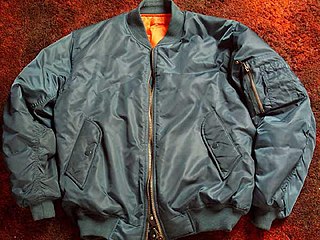 W
WA flight jacket is a casual jacket that was originally created for pilots and eventually became part of popular culture and apparel. It has evolved into various styles and silhouettes, including the "letterman" jacket and the fashionable "bomber" jacket that is known today.
 W
WElizabeth Handley-Seymour (1867–1948) was a London-based fashion designer and court-dressmaker operating as Madame Handley-Seymour between 1910 and 1940. She is best known for creating the wedding dress worn by Elizabeth Bowes-Lyon, the future Queen Elizabeth The Queen Mother, for her marriage to the Duke of York in 1923; and later, Queen Elizabeth's coronation gown in 1937.
 W
WHarem pants or harem trousers are baggy, long pants caught in at the ankle. Early on, the style was also called a harem skirt. The original so-called 'harem pants/skirts' were introduced to Western fashion by designers such as Paul Poiret around 1910, although they themselves were inspired by Middle East styles, and by şalvar. The term 'harem pants' subsequently became popular in the West as a generic term for baggy trousers caught in at the ankle that suggest the Turkish style, or similar styles such as bloomers, the South Asian shalwar and patiala salwar; the Bosnian dimije; sirwal ; and the Ukrainian sharovary.
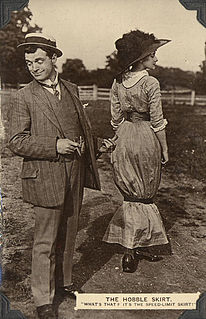 W
WA hobble skirt was a skirt with a narrow enough hem to significantly impede the wearer's stride. It was called a "hobble skirt" for that very reason; it seemed to hobble any woman as she tried to walk around while wearing one. Hobble skirts were a short-lived fashion trend that peaked between 1908 and 1914.
 W
WA homburg is a semi-formal hat of fur felt, characterized by a single dent running down the centre of the crown, a wide silk grosgrain hatband ribbon, a flat brim shaped in a "pencil curl", and a ribbon-bound trim about the edge of the brim. It is traditionally offered in black or grey.
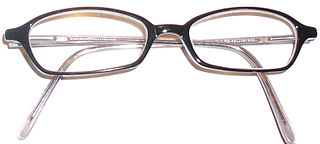 W
WHorn-rimmed glasses are a type of eyeglasses. Originally made out of either horn or tortoise shell, for most of their history they have actually been constructed out of thick plastics designed to imitate those materials. They are characterized by their bold appearance on the wearer's face, in contrast to metal frames, which appear less pronounced.
 W
WKeds is an American brand of canvas shoes with rubber soles. Founded in 1916, the company is owned by Wolverine World Wide. The original shoe design, the Champion, was the first mass-marketed canvas-top "sneaker."
 W
WThe L'Eplattenier helmet was a prototype military helmet designed for the Swiss Army by Charles L'Eplattenier in 1916. Deemed too expensive to produce en masse, it was shunned in favour of a simpler design.
 W
WThe maillot is the fashion designer's name for a woman's one-piece swimsuit, also called a tank suit. A maillot swimsuit generally consists of a tank-style torso top with high-cut legs. However, a maillot may also include a plunging neckline, turtleneck-style top, or revealing cutouts.
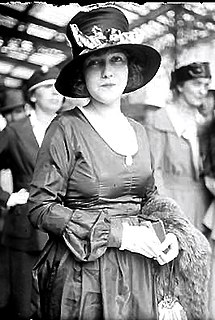 W
WA mushroom hat is a millinery style in which the brim of the hat tilts downwards, resembling the shape of a mushroom. It is a style that first emerged in the 1870s and 1880s, when it was usually made of straw. It became fashionable again from around 1907 to the late 1920s; these versions featured a distinctly downturned brim although the size and shape of the crown varied according to prevailing fashions.
 W
WThe newsboy cap, newsie cap or baker boy hat (British) is a casual-wear cap similar in style to the flat cap.
 W
WA peach basket hat is a millinery design that resembles an upturned country basket of the style typically used to collect fruit. Generally it is made of straw or similar material and it often has a trimming of flowers and ribbons. Some models may also feature a veil or draped fabric covering. It was introduced in around 1908 and caused some controversy over the succeeding year due to its extreme dimensions and decorations. It had revivals – designs were at this stage more modest – in the 1930s and 1950s.
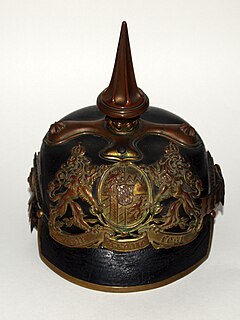 W
WThe Pickelhaube, also Pickelhelm, is a spiked helmet that was worn in the 19th and 20th centuries by Prussian and German military, firefighters and police. Although it is typically associated with the Prussian Army, which adopted it in 1842–43, the helmet was widely imitated by other armies during that period. It is still worn today as part of ceremonial wear in the militaries of certain countries, such as Sweden, Chile, and Colombia.
 W
WThe pith helmet also known as the safari helmet, sun helmet, topee, sola topee, topi, or salacot, is a lightweight cloth-covered helmet made of sholapith. The pith helmet is an adaptation of the native salakot headgear of the Philippines.
 W
WPaul Poiret was a French fashion designer, a master couturier during the first two decades of the 20th century. He was the founder of his namesake haute couture house. His contributions to his field have been likened to Picasso's legacy in 20th-century art.
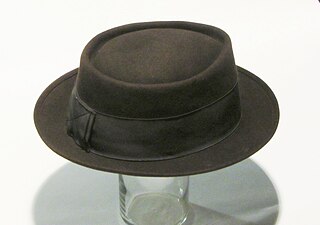 W
WA pork pie hat is one of several different styles of hat that have been popular since the mid-19th century, all of which bear superficial resemblance to a pork pie.
 W
WEmily Margaret Tinne was a British collector of clothes. Raised by a Presbyterian missionary to India, Tinne attended boarding school in England. She trained and worked as a teacher before marrying a wealthy doctor in 1910, at which point she started buying clothes from department stores in Bold Street, Liverpool, as well as having bespoke items made by a local dress maker. Her collection, which has been donated to the National Museums Liverpool, contains over 700 items and is the largest from an individual owned by a museum in the United Kingdom. The clothes are of high quality, with many items still unworn in their original tissue paper and boxes, the price tags and delivery information still attached.
 W
WA trilby is a narrow-brimmed type of hat. The trilby was once viewed as the rich man's favored hat; it is sometimes called the "brown trilby" in Britain and was frequently seen at the horse races.